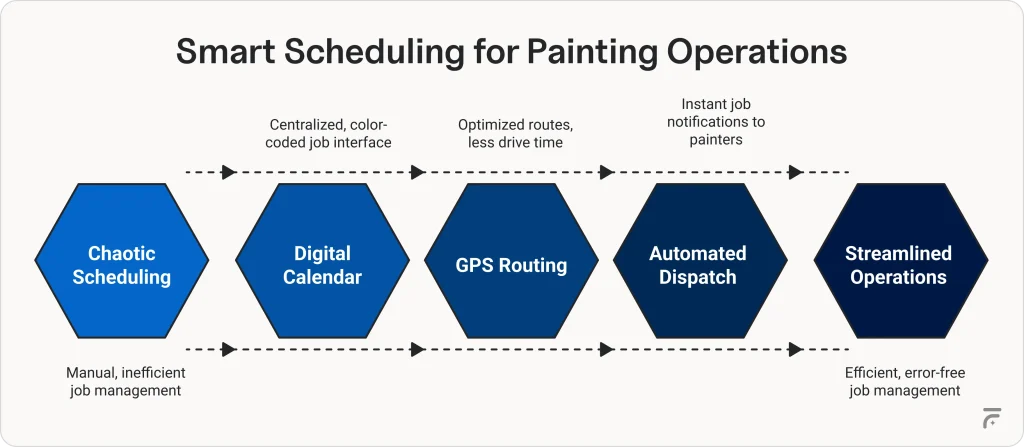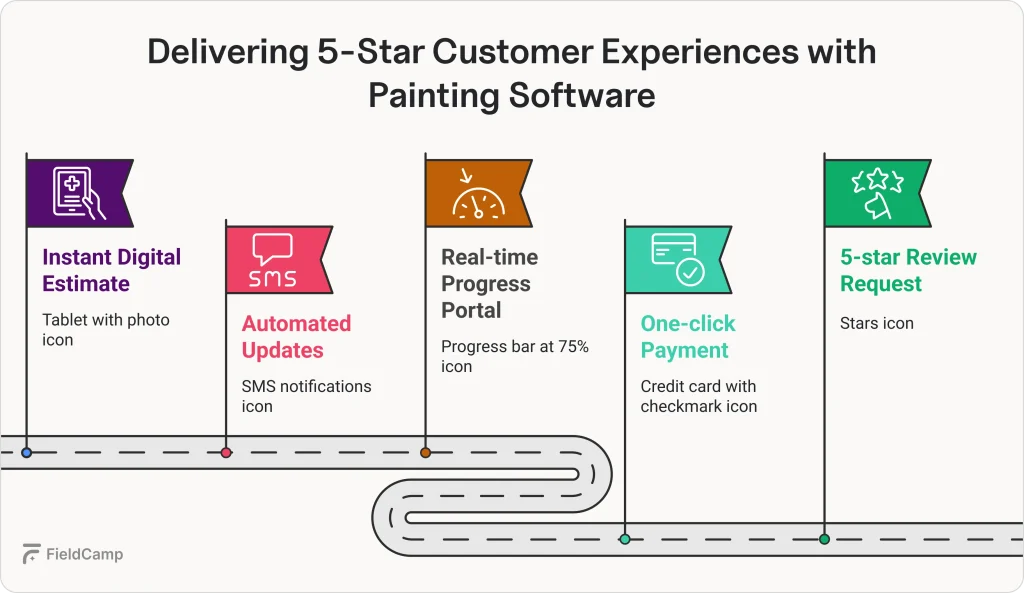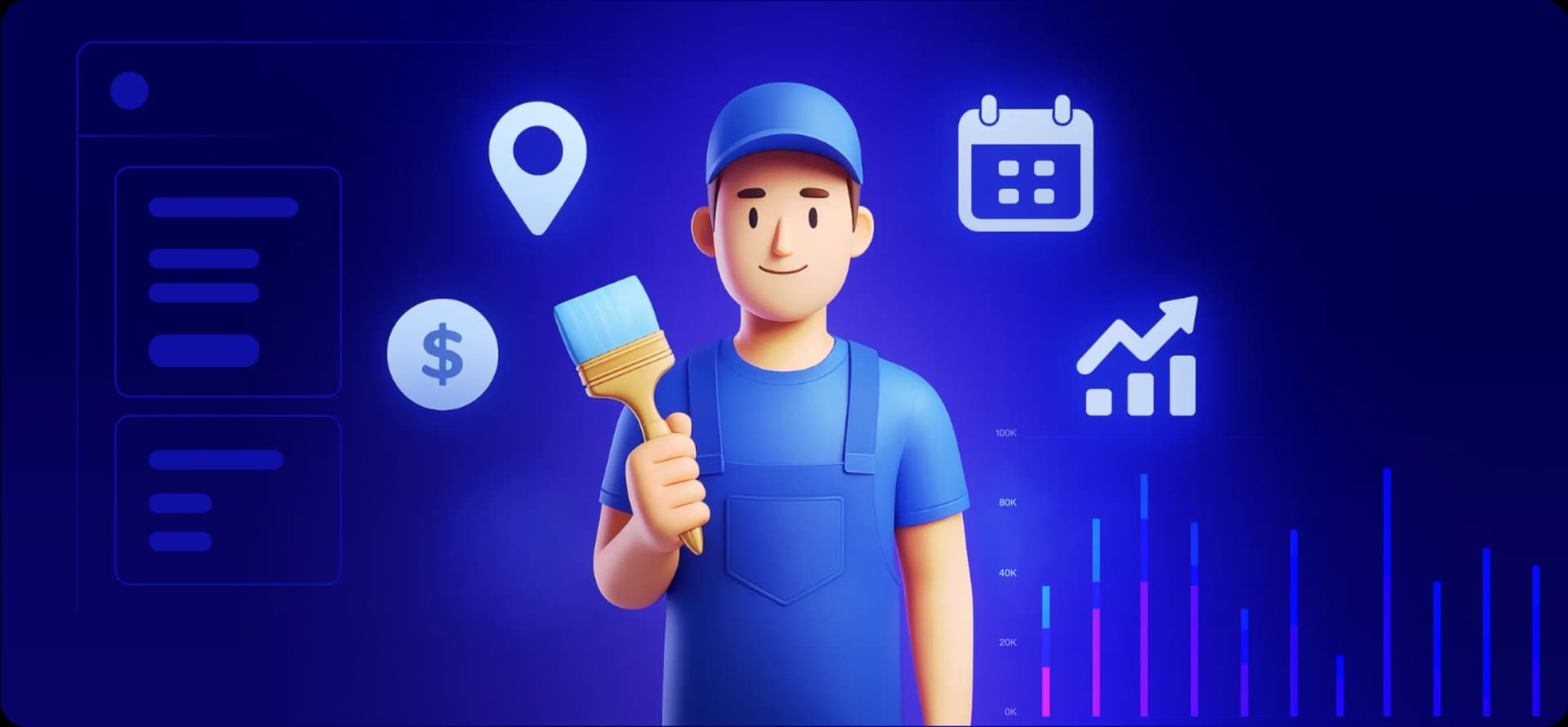The painting contractors market is expected to reach $243.41 billion by 2027, yet most contractors remain trapped in operational quicksand. Bidding blindly, scheduling manually, and hemorrhaging profits through inefficiencies they can’t even measure.
Why? Because, while demand soars and labor shortages persist, the majority of contractors have not yet embraced the digital tools that could transform their operations.
Meanwhile, a growing segment of data-driven contractors is quietly dominating their markets using painting software solutions to unlock insights, automate workflows, and scale strategically.
The gap between digital adopters and traditional operators continues to widen daily. Here’s what separates tomorrow’s market leaders from those who’ll struggle to survive.
Before exploring the benefits, let’s define what painting contractor software is and its significance.
Painting contractor software is a digital platform that centralizes your entire business operations, from initial estimates and scheduling to project management and final invoicing, into one streamlined system.
If you’d like to see these concepts in action with visuals that break down business growth step by step, check out our YouTube video based on this very blog.
Benefits of Using Painting Contractor Software
Let’s explore the transformative benefits that make this investment essential for contractors serious about efficiency, profitability, and sustainable growth.
1. Operational efficiency
Painting contractor software transforms chaotic daily operations into streamlined workflows through specific automation features:
Job Scheduling & dispatch:
Remember the morning scramble of figuring out who goes where? That’s history. Modern scheduling features eliminate the chaos of whiteboards and sticky notes by providing a clear, drag-and-drop calendar view of all your jobs and crews. You can instantly see who’s available, what equipment they have, and which projects are nearby.
When that downtown commercial project comes in, you simply drop it onto the crew schedule, and the system shows they’re finishing up just three blocks away and have the necessary equipment on their truck. No more calling five different crew leaders to figure out availability.

The AI-powered routing even suggests the most efficient job order to minimize drive time, but the real magic is simply having everything visible in one place.
Real-time project tracking:
Gone are the days of playing telephone to get project updates. Your crews simply tap their progress in the mobile app: “prep complete,” “first coat done,” “final walkthrough,” and you’re watching it happen in real-time from anywhere.
Better yet, clients get automatic updates too.
Contractors can benefit from this feature by saving them two hours daily of “just checking in” calls. The GPS tracking also means that customer calls asking when her crew will arrive, you can share “they’re 12 minutes away” without a doubt.
Smart inventory management:
Here’s where things get intelligent. The software tracks exactly what materials each job consumes, building a clear picture of your usage patterns. You’ll always know that exterior jobs average 15 gallons while interiors use 8, helping you quote accurately and order appropriately.
When inventory dips below your set minimums, you get instant alerts with pre-filled purchase orders.
The AI component learns your seasonal patterns over time, suggesting you stock up before your busy summer season, even without the predictive features. Simply knowing what you have and what you need transforms inventory management from guesswork to precision.
2. Financial Impact
The financial benefits of painting contractor software extend beyond simple cost savings. It fundamentally changes how you understand and control your business finances.
Key financial improvements:
| Metric | Impact | How it works |
|---|---|---|
| Job Costing Accuracy | Track actual vs. estimated costs in real-time | Mobile time tracking captures exact hours worked (no more “rounding up” by crews). Material scanning logs precise paint usage. Example: You quoted 16 hours for a bedroom repaint, but tracking shows it took 22 hours—now you know to adjust future quotes. |
| Cash Flow Acceleration | Get paid 2-3 weeks faster | Send invoices instantly upon job completion with photos of finished work. Automated payment reminders go out at 7, 14, and 21 days. Clients can pay via credit card with one click, putting money in your account within 48 hours instead of waiting 30+ days for checks. |
| Estimate Win Rate | Close 20-30% more bids | Professional estimates with photos, material options, and payment plans outsell handwritten quotes. The software shows which estimate templates convert best, so you can replicate winning formulas. Track why you lose bids to adjust pricing strategically. |
| Overhead Reduction | Cut administrative costs by 40% | Eliminate 15+ hours weekly of data entry, phone tag, and paperwork. One office manager can handle what previously required two people. Less pay for overtime and more time for invoicing or job costing. |
| Material Cost Control | Reduce waste by 15-25% | Track exactly how much paint each painter uses per square foot. Identify who’s overspraying or not calculating correctly. Bulk ordering insights show you’re paying $32/gallon buying weekly when monthly orders would cost $27/gallon. |
| Profit Margin Visibility | Know your margins on every job | Dashboard shows real-time profitability: Labor costs + materials + overhead = true job cost. Discover that small residential jobs yield 15% margins while commercial repaints deliver 40% then adjust your marketing focus accordingly. |
Example: Martinez Painting discovered their “quick touch-up” service was losing $50 per job once true drive time was factored in. They raised the minimum charge from $200 to $350, lost only 10% of those jobs, and turned a money-loser into a profitable service.
Meanwhile, their commercial repaint margins were higher than expected, so they shifted marketing focus and increased revenue by 35% in six months..
3. Customer Experience
Modern painting contractor software transforms customer interactions from frustrating to seamless through specific touchpoint improvements:
Professional first impressions:
Create estimates on-site using tablet apps that pull from your preset pricing catalog. Include photos of problem areas, material options with visuals, and detailed scope breakdowns.
Customers receive a branded PDF estimate via email before you leave their driveway, not a handwritten quote on carbon paper days later.
Proactive communication:
Automated SMS notifications keep clients informed without you lifting a finger:
- “Hi [Client name], your painting crew will arrive tomorrow between 8-10 AM.”
- “Day 2 update: Primer complete, paint application begins tomorrow.”
- “Your project is complete! Please click here to view photos and approve the work.”

Transparent project management:
Customers access a portal showing their project timeline, progress photos, and any change orders. When they ask to add crown molding mid-project, they approve the additional cost digitally, eliminating payment disputes later.
Simplified payment options:
Accept credit cards, ACH transfers, or financing options directly through the platform. Customers pay with one click from their invoice email, and funds hit your account in 1-2 days without chasing checks for weeks.
4. Business Growth
Painting contractor software provides the data and scalability needed to grow strategically rather than chaotically:
Data-driven decision making:
Built-in analytics reveal game-changing insights, such as:
- Which zip codes generate your highest-margin jobs
- What percentage of estimates convert (and why others don’t)
- Which crew completes jobs fastest without sacrificing quality
- Peak booking seasons to plan marketing campaigns around
- Most profitable services to promote vs. those to phase out
Scalability without complexity:
Add crews, expand territories, or launch new services without proportional administrative burden. A comprehensive workforce management platform enables:
- New employees are onboarded through the app with training videos and digital paperwork
- Multi-location scheduling works identically whether you have 2 crews or 20
- Standardized processes ensure consistent quality across all teams
- Performance dashboards help identify top performers to promote to crew leaders
Marketing integration:
The software feeds your growth by:
- Automatically requesting reviews after job completion (boosting your Google rating)
- Tracking lead sources to show which marketing channels deliver ROI
- Creating before/after galleries for social media content
- Generating customer lists for targeted email campaigns
Example: A solo contractor using painting software added three crews in 18 months without hiring office staff, growing from $300K to $1.2M annual revenue while maintaining 30% profit margins.
See how contractors of every size, from solo operations to large crews, are benefiting from who need painting contractor software guide.
5. Time-Saving Benefits
Here’s how painting contractor software reclaims your time:
- Estimates: Cut from 2 hours to 15 minutes using templates, preset pricing, and photo integration
- Daily scheduling: Reduce 90 minutes of morning calls to 5 minutes of drag-and-drop adjustments
- Invoice creation: Batch process 50 invoices in 10 minutes vs. 3 hours manually
- Payroll prep: Export time tracking data directly to payroll, save 6-8 hours weekly
- Supply ordering: One-click reorders based on preset minimums, save 3 hours weekly
- Customer updates: Automated progress texts eliminate 20-30 daily “status check” calls
- Job costing: Real-time profitability reports replace 5 hours of weekend spreadsheet work
- Lead follow-up: Automated email sequences nurture prospects without your involvement
The Bottom Line: Most contractors save 15+ hours per week on administrative tasks. That’s two full days you can spend selling more jobs, managing projects better, or finally taking weekends off.
Conclusion
The benefits of painting contractor software extend far beyond simple digitization of paper processes. By embracing these comprehensive platforms, painting contractors can reduce admin errors, dramatically improve efficiency, and increase profitability in ways that manual systems simply cannot match.
From streamlining operations to enhancing customer satisfaction, the advantages touch every aspect of the business.
Painting contractor software is no longer a nice-to-have; it’s an essential tool for contractors serious about growing their business and staying ahead of the competition. The question isn’t whether to adopt this technology, but how quickly you can implement it to start reaping these transformative benefits.
Plan. Paint. Prosper.
Organize your jobs, track your crews, and accelerate payments with FieldCamp – the smart way to run your painting contractor business.
Frequently Asked Questions
What is the most important task for a painting contractor?
Accurate project estimation and job costing. This determines whether you make or lose money on every job. Without knowing your true costs, labor, materials, and overhead, even busy contractors can operate at a loss. Successful painters prioritize tracking actual costs against estimates to refine pricing and protect profits.
How can painting contractor software boost my business efficiency?
By automating time-draining tasks. Schedule jobs in seconds instead of hours. Get instant field updates instead of playing phone tag. Create invoices with one click. Most contractors save hours weekly on admin work by using AI-powered painting contractor software.
What makes accurate estimating a key benefit of painting software?
It uses your real job data, not industry guesswork. The software tracks your actual labor times and material usage, then applies these to new estimates. Resulting in more bids with competitive pricing while protecting margins, and converting more quotes with professional digital proposals.
How does digital scheduling improve team productivity for painters?
Smart routing cuts drive time, and crews get schedules on their phones with all job details. Quick reassignments handle cancellations or weather delays. Your teams complete more jobs daily without working longer hours, directly boosting revenue per employee.
In what ways does CRM integration enhance customer relationships?
It turns one-time clients into repeat customers. Automated follow-ups bring maintenance work. Customer history means personalized service; you’ll know Mrs. Johnson prefers Benjamin Moore paint before she reminds you. This personal touch generates more referrals.
What do painters charge per day?
Painters can charge varying prices by location and experience. But smart contractors have moved beyond day rates to value-based pricing that accounts for project complexity, materials, and overhead. For a detailed pricing strategy guide, see: How much to charge for painting services—it covers everything from calculating rates to pricing different project types.

